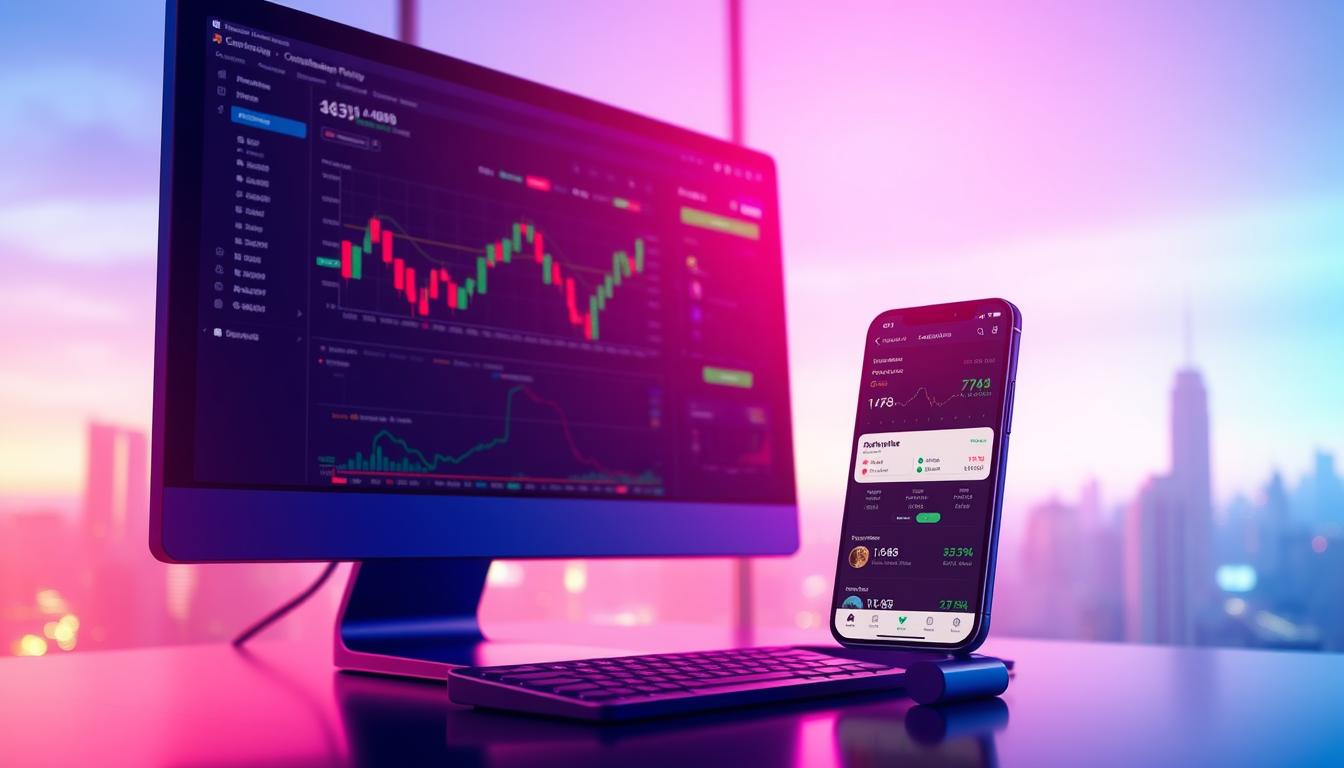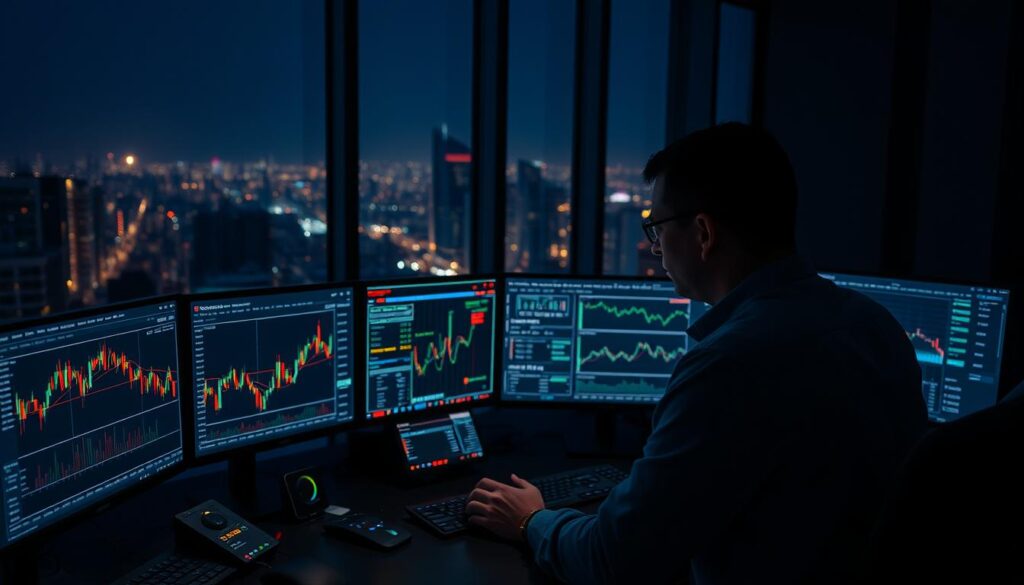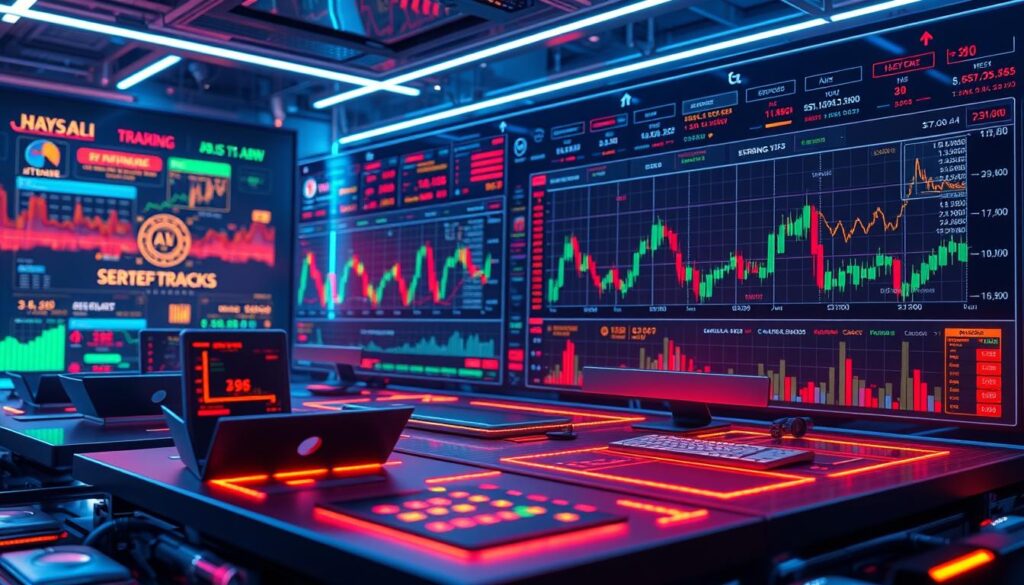Now Reading: Review of best AI crypto copytrading platforms ranked
- 01
Review of best AI crypto copytrading platforms ranked
Review of best AI crypto copytrading platforms ranked

The landscape for automated digital asset trading has transformed. New tools let you mirror the moves of experienced traders. This approach has gained massive popularity recently.
More people are joining these services due to better performance tracking. This guide looks at the leading services available today. We focus on what makes each one stand out.
Our research combines trading data, user feedback, and platform stats. Names like Binance, Bybit, MEXC, and OKX often lead the pack. These services offer vast networks of traders and thousands of markets.
We examine critical factors for you. This includes trader pool size, supported coins, and fee models. Security features like two-factor authentication are also vital.
Key Takeaways
- The market for automated trading services has expanded significantly.
- Leading platforms provide access to thousands of verified traders and markets.
- Key evaluation points are fees, leverage options, and security protocols.
- Profit-sharing models and trading commissions vary between services.
- This analysis helps you choose based on your personal investment goals.
- Real-world performance data and user reviews inform our rankings.
Overview of AI Crypto Copytrading Platforms
Investment methodologies have undergone significant transformation with technological advancements. Modern systems combine sophisticated algorithms with social trading features. This creates continuous automated investment solutions for volatile markets.

These services act as intermediaries between experienced traders and followers. Users can replicate successful strategies without deep technical knowledge. The technology instantly mirrors trades from selected experts.
Followers receive identical entry and exit positions. They can customize investment amounts and risk levels. Major services process millions of trades daily across thousands of digital asset pairs.
The ecosystem includes various approaches. Some focus purely on human trader replication. Others offer hybrid systems with pre-programmed strategies.
This technology democratizes access to professional-grade strategies. Retail investors with limited capital can benefit from proven expertise. The industry has matured with transparent metrics and risk tools.
| Service Type | Primary Focus | Key Features | Ideal For |
|---|---|---|---|
| Pure Copy Trading | Human Strategy Replication | Real-time mirroring, performance history | Beginners seeking guidance |
| Automated Bots | Algorithmic Execution | Technical indicators, 24/7 operation | Hands-off investors |
| Hybrid Systems | Combined Approaches | Flexible customization, multiple options | Versatile users |
Leading services now offer sophisticated filtering systems. Users can identify strategies aligning with their goals. Backtesting capabilities help validate approach effectiveness before implementation.
Benefits of AI-Driven Trading in the Cryptocurrency Market
Automated trading solutions offer compelling benefits that enhance investment outcomes in volatile markets. These systems remove emotional biases that often lead to poor decisions during price swings.

Continuous market participation represents a major advantage. Automated systems operate 24/7 without fatigue, capturing opportunities across all time zones.
| Benefit Category | Human Trading | Automated Approach | Impact Level |
|---|---|---|---|
| Emotional Control | Subject to fear/greed | Rule-based execution | High |
| Market Coverage | Limited by sleep hours | 24/7 operation | Very High |
| Strategy Testing | Manual backtesting | Automated validation | Medium |
| Execution Speed | Human reaction time | Instantaneous | High |
Backtesting capabilities let traders validate approaches using historical data. This reduces risk before committing real capital to live markets.
Speed advantages are particularly valuable in fast-moving conditions. Automated systems execute trades instantly, capturing brief opportunities.
Systematic risk management protects investments through predefined rules. Stop-loss orders and position sizing work automatically according to your strategy.
Understanding Automated Trading Bots in Crypto
Digital trading tools have evolved into sophisticated systems that operate independently. These programs connect directly to exchanges through secure interfaces. They monitor market conditions around the clock.

Sophisticated algorithms power these automated systems. They analyze market data and execute trades based on predefined rules. This creates efficient trading processes that work continuously.
How AI Bots Enhance Trading Efficiency
These systems process information much faster than human traders. They identify opportunities using technical indicators and historical patterns. Execution happens instantly when conditions match strategy parameters.
Machine learning allows these tools to adapt to changing market conditions. They learn from past performance to improve future decisions. This creates increasingly effective trading approaches over time.
Security Protocols and Risk Management
Strong security measures protect user accounts and funds. Two-factor authentication and encryption prevent unauthorized access. API connections often have limited permissions for safety.
Quality systems include built-in risk management features. These include stop-loss orders and position size controls. Such tools help protect capital during market volatility.
When selecting a trading bot, security should be your primary concern. Look for transparent practices and regular security audits. Proper risk management ensures sustainable participation in markets.
The Role of Backtesting and Data-Driven Trading Strategies
Historical market data provides invaluable insights for developing robust trading approaches. Backtesting allows you to validate your methodology before risking real capital. This process simulates how strategies would have performed using past market conditions.

Think of backtesting as a rehearsal that builds confidence and fine-tunes your approach. Quality systems offer granular control over parameters like timeframes and trading pairs. This ensures simulations reflect real-world conditions accurately.
Importance of Historical Data Analysis
Data-driven trading strategies rely on statistical analysis rather than emotional reactions. This leads to more consistent results over time. Historical analysis reveals how approaches perform during different market phases.
Traders can compare multiple trading strategies side-by-side. This helps identify which methods deliver superior risk-adjusted returns. The insights enable continuous refinement based on empirical evidence.
Advanced systems offer forward testing with virtual funds. This provides additional validation before live deployment. Proper backtesting transforms speculative decisions into calculated investment approaches.
Key Factors to Look for in an AI Crypto Trading Platform
Choosing the right digital asset trading service requires careful consideration of several critical elements. Your selection should align with your financial objectives and comfort level with market fluctuations.
Begin by defining your investment timeline and goals. Are you seeking quick returns or building long-term wealth? Different services cater to various time horizons and strategy types.
Risk Tolerance and Customization Options
Your personal risk tolerance fundamentally shapes which trading platform suits you best. Services range from conservative spot trading to high-leverage futures options.
Exchange compatibility determines your market access. Leading platforms connect to major venues like Binance and Coinbase. This ensures competitive pricing and reliable trade execution.
Understanding fee structures prevents unexpected costs. Look for transparent pricing models including subscription fees and performance commissions. Hidden charges can significantly impact your returns.
Customization features allow you to tailor strategies to your needs. Adjustable parameters for position sizing and stop-loss orders provide crucial risk management controls. The ability to follow multiple traders enhances diversification.
- Evaluate interface quality for easy monitoring and adjustments
- Verify security protocols including two-factor authentication
- Assess customer support responsiveness and educational resources
These factors collectively determine whether a service matches your trading approach. Proper evaluation ensures you select a platform that supports your financial goals.
In-Depth Analysis of Platform Functionalities and Features
Modern trading services distinguish themselves through unique proprietary tools and specialized functionalities. Each platform offers distinct advantages that cater to different investor preferences and skill levels.
Services like 3Commas provide advanced order types through their SmartTrade terminal. These trading bots handle dollar-cost averaging, grid systems, and options strategies efficiently.
Cryptohopper stands out with comprehensive backtesting capabilities and strategy design tools. Their marketplace lets users buy and sell proven trading strategies from experienced developers.
Grid trading represents a popular approach for capturing profits during market fluctuations. This method places multiple orders at predetermined price intervals automatically.
Arbitrage tools identify price differences across exchanges for risk-free opportunities. Dollar-cost averaging bots remove emotional timing by investing fixed amounts regularly.
Advanced platforms also offer portfolio management features including automatic rebalancing. Some provide derivative trading capabilities for sophisticated hedging strategies.
Integration with external tools like TradingView enhances technical analysis options. Customization depth varies from simple presets to full scripting languages for advanced users.
These diverse functionalities allow investors to select services matching their specific needs. The right combination of tools can significantly improve trading outcomes.
Comparing Trading Fees, Pricing Models, and Commission Structures
Understanding the complete cost structure of automated trading services is essential for maximizing investment returns. Different platforms employ varied fee models that significantly impact your net profits over time.
Spot trading commissions typically range from 0% to 0.1% per transaction. Some services like MEXC offer zero-fee maker orders while charging minimal taker fees. Derivatives trading often features lower percentage rates around 0.02-0.05%.
Profit-sharing arrangements represent another critical cost component. Most platforms charge between 10% and 20% of net gains to successful traders. However, some services like PrimeXBT retain up to 40% of profits for standard users.
Subscription models add another layer to cost considerations. Services like 3Commas charge $49 monthly for Pro plans, while Cryptohopper’s premium tiers reach $107.50 monthly. Meanwhile, platforms like Pionex offer free trading bots with minimal transaction fees.
Hidden costs require careful attention. These include withdrawal fees, currency conversion charges, and premium feature access costs. Volume-based discounts can reduce expenses for active traders.
When evaluating any trading platform, conduct a thorough cost-benefit analysis. Sometimes slightly higher fees are justified by superior execution quality or better trader selection on the crypto exchange.
User Interface and Experience: Ease of Use for Beginners and Pros
Navigating a trading platform should feel intuitive, not intimidating. The design directly impacts how quickly you can get started with your first automated strategy.
Clean layouts like those on Coinrule and Bitunix help newcomers avoid confusion. These services use visual guides and simple menus.
Dashboard clarity is crucial for monitoring performance effectively. The best interfaces display key metrics without visual clutter.
Beginner-focused systems offer guided onboarding and preset templates. This approach prevents analysis paralysis while building confidence.
Advanced users need customizable layouts and detailed analytics. Professional tools include multiple chart windows and API access.
Mobile application quality is increasingly important. Native iOS and Android apps allow monitoring from anywhere.
Essential interface elements include:
- Robust search and filtering for trader selection
- Visual performance charts and heat maps
- Responsive design across all devices
- Fast loading times for time-sensitive decisions
The right combination of simplicity and power suits different experience levels. This ensures both newcomers and experts can trade effectively.
Integration with Leading Cryptocurrency Exchanges and Tools
Seamless connection with established digital asset marketplaces forms the backbone of any effective automated trading system. Top services link to numerous major venues, providing a unified gateway to global markets.
This broad access is crucial. It allows you to follow strategies across thousands of different trading pairs from a single dashboard. Services like 3Commas and Bitsgap connect to over 15 major crypto exchanges.
The advantages of this multi-exchange approach are significant:
- Enhanced market access: You are not limited to the assets on one platform.
- Improved reliability: If one exchange has issues, trading can continue on others.
- Arbitrage potential: Systems can exploit price differences across various marketplaces.
Security is paramount in these integrations. Platforms use read-only API keys to prevent unauthorized fund withdrawals. This protects your capital while enabling trade execution.
Furthermore, deep liquidity on connected exchanges ensures your copy trades fill at expected prices. This minimizes slippage, especially for larger orders. Integration with tools like TradingView also adds powerful charting and analysis capabilities directly into the workflow.
The Impact of Deep Liquidity and Futures Trading Options
Advanced trading strategies rely heavily on robust liquidity pools and flexible position options. These elements determine execution quality and strategic possibilities across digital markets.
Deep liquidity ensures orders fill quickly at expected prices. This prevents slippage that can erode profits during volatile conditions. Major venues like Binance provide institutional-grade execution with tight spreads.
High trading volume creates substantial order book depth. This allows large positions to execute without significantly moving market prices. The result is improved profitability for all participants.
Futures trading expands strategic possibilities dramatically. Traders can profit from both rising and falling markets. Platforms offer leverage ranging from 25x to 200x on various assets.
Services like Bybit provide access to hundreds of derivatives markets. OKX supports both perpetual and delivery futures contracts. These options enable sophisticated hedging strategies.
The combination of deep liquidity and diverse futures options supports advanced approaches. Traders can implement strategies that perform consistently across different market conditions.
Insights into Automated Trading for Diverse Market Conditions
Successful automated approaches thrive by recognizing and responding to shifting market environments. Different trading strategies perform optimally under specific conditions.
| Market Condition | Recommended Strategy | Key Features | Ideal Use Case |
|---|---|---|---|
| Trending Markets | Momentum-Based | Breakout patterns, moving averages | Capturing sustained directional moves |
| Ranging/Sideways | Grid Trading | Support/resistance boundaries | Profiting from price oscillations |
| High Volatility | Dollar-Cost Averaging | Systematic entry averaging | Reducing timing risk during swings |
| Low Volatility | Mean Reversion | Price return to averages | Consolidation phase opportunities |
Advanced trading bots adapt through machine learning. They analyze patterns and adjust parameters automatically. This market analysis ensures optimal performance across changing conditions.
Risk management remains crucial regardless of market phase. Consistent capital allocation and diversification protect against unexpected behavior. Multi-strategy approaches combine different automated trading systems.
This creates portfolios that perform well in various environments. The right combination ensures consistent results through market cycles.
Best AI crypto copytrading platforms ranked: Ranking Criteria and Analysis
Our ranking methodology combines hard data analysis with real-world platform performance to identify superior trading environments. This approach ensures a balanced evaluation that serves diverse investor needs.
Criteria for Inclusion and Platform Evaluation
We assess services across multiple dimensions to determine their overall quality. Reputation and user feedback provide crucial insights into reliability.
Functionality breadth matters significantly. Services supporting various strategies like DCA and grid trading offer more flexibility. Integration with major exchanges expands market access.
| Criteria Category | Key Factors | Importance Level | Assessment Method |
|---|---|---|---|
| Security & Compliance | 2FA, encrypted APIs, regulatory status | Critical | Security audits, breach history |
| User Experience | Interface design, mobile access, onboarding | High | Usability testing, user reviews |
| Trader Pool Quality | Verification standards, performance history | Very High | Statistical analysis, vetting processes |
| Pricing Transparency | Fee structures, hidden costs, value proposition | High | Cost comparison, total expense analysis |
Performance Metrics and User Reviews Insights
Quantitative measurements provide objective performance indicators. Return on investment shows absolute gains, while Sharpe ratios measure risk-adjusted returns.
Maximum drawdown reveals worst-case scenarios during market stress. The win rate metric requires careful interpretation since high percentages don’t always mean better outcomes.
Consistency across different timeframes indicates sustainable performance. User feedback from independent sources offers real-world reliability insights. Security track records and dispute handling complete the evaluation picture.
The top crypto services balance large trader pools with comprehensive features. They provide competitive fee structures and strong protection measures.
Case Studies and Real-World User Experiences
Examining actual user journeys reveals valuable insights beyond technical specifications. Real people share what works in practice.
MEXC has processed over 2 million copy positions for 50,000 investors. Their pool includes 21,000+ traders. Binance serves 270 million users with massive quarterly volume.
Successful investors choose top traders strategically rather than chasing recent returns. They understand that past performance doesn’t guarantee future results.
Many experienced users diversify across multiple top traders with complementary approaches. This balances different market strategies effectively.
Beginners should get started with small amounts while learning platform mechanics. Many recommend $100-500 initial investments for digital asset trading.
Understanding risk tolerance is crucial when selecting strategies. Some traders achieve high returns with significant volatility. Others offer more consistent results.
Pay attention to metrics like win rate and maximum drawdown. These indicators help assess strategy stability during different market conditions.
Platforms provide demo trading for practice before committing real funds. This helps users understand how copy trading works in real digital asset markets.
Evaluating Customization and Flexibility in Trading Strategies
Personalization capabilities in modern trading environments empower users to align automated approaches with their specific financial goals. The depth of customization available determines whether a service offers genuine flexibility or merely provides one-size-fits-all solutions.
Custom Strategy Options and Automated Adjustments
Advanced systems allow followers to copy trader signals while modifying key parameters. Users can adjust position sizes, leverage multipliers, and stop-loss distances to match personal risk tolerance. This customization ensures strategies align with individual comfort levels.
Margin mode selection provides crucial control over exposure. Options include following the lead trader’s approach or using isolated margin that limits losses. Cross margin utilizes the entire account balance for more aggressive positions.
Sophisticated filtering enables strategic trader selection based on dozens of criteria. Users can filter by preferred trading pairs, position duration, and drawdown levels. This helps identify approaches matching specific investment objectives.
Strategy marketplaces create ecosystems where developers monetize proven algorithms. Platforms like Cryptohopper allow purchasing, selling, or renting tested approaches. Script-based customization through programming languages enables building completely custom indicators.
Portfolio construction flexibility allows combining multiple strategies with different capital allocations. Machine learning represents the cutting edge, with some systems dynamically modifying parameters based on changing market conditions.
Emerging Trends and Future Outlook of AI Crypto Copytrading
Forward-looking developments in social investment technology point toward increasingly sophisticated user experiences. The market for automated strategy replication has expanded rapidly with growing retail participation.
Machine learning models are becoming more advanced. They analyze market sentiment from various data sources. This improves prediction accuracy for price movements.
Decentralized finance integration represents a major innovation. New systems connect automated strategy replication to decentralized exchanges. This reduces dependence on centralized services.
Social trading communities are evolving beyond basic functionality. Traders now share detailed analysis and collaborate on strategy development. Educational content helps users develop their skills.
Regulatory clarity is gradually emerging in major markets. This separates compliant services from unregulated alternatives. Mobile-first design dominates as younger investors expect full smartphone capabilities.
Asset support continues to expand across major services. Thousands of tokens including experimental assets are now available. This caters to traders seeking diverse opportunities.
Institutional adoption grows as professional managers recognize these tools. They use them for digital asset exposure while outsourcing active management. The future suggests consolidation around comprehensive services with strong security features.
Conclusion
As we conclude our exploration of automated trading platforms, the key takeaway is that success hinges on aligning platform capabilities with individual investment objectives. The best crypto services each serve distinct needs, from MEXC’s extensive trader network to Binance’s institutional-grade liquidity.
Effective participation requires understanding your personal risk tolerance and selecting strategies accordingly. A trading platform that also offers futures specialization like Margex may suit experienced investors, while platforms like BloFin appeal to privacy-focused users.
To get started with crypto trading, begin with small investments while learning platform mechanics. Carefully evaluate performance metrics and diversify across multiple traders to manage exposure.
The evolution of automated trading has created powerful tools for market participation, but sustainable success demands disciplined risk management and regular strategy evaluation.
FAQ
What is automated trading in the cryptocurrency market?
Automated trading uses software, often called a trading bot, to execute trades automatically based on pre-set strategies. These tools analyze market data and place orders without constant manual input, aiming to improve efficiency and capitalize on opportunities 24/7.
How do I manage risk when using an automated trading bot?
Effective risk management involves setting clear parameters like stop-loss and take-profit orders. You should also choose a platform that offers customization options to align with your personal risk tolerance. Diversifying strategies and starting with a demo account can further mitigate potential losses.
Are these platforms suitable for beginners?
Yes, many platforms are designed with user-friendly interfaces that make getting started straightforward for beginners. They often provide features like copying top traders, which allows new users to leverage the experience of seasoned professionals without needing deep market analysis skills.
What trading pairs and markets are typically available?
Most leading services support a wide range of trading pairs, including major cryptocurrencies like Bitcoin and Ethereum. Many also offer access to futures trading and other markets, providing diverse options for different trading strategies.
How important are trading fees when selecting a service?
Trading fees and commission structures directly impact your overall profitability. It’s crucial to compare pricing models, as some platforms charge a percentage of profits, while others have fixed fees. Look for transparent pricing to avoid unexpected costs.
Can I test strategies before using real funds?
Absolutely. Backtesting is a key feature on many services, allowing you to test your trading strategies against historical data. This data-driven approach helps refine your approach and assess potential performance before risking capital.
What security measures should I look for?
Prioritize platforms with robust security protocols, such as two-factor authentication (2FA), encryption, and cold storage for funds. The best exchanges also have a strong track record of protecting user assets and maintaining system integrity.
How does deep liquidity benefit my trades?
Deep liquidity on an exchange means there are enough buyers and sellers to execute orders quickly and at desired prices. This reduces slippage and helps ensure that your automated trades are filled efficiently, which is crucial for strategy success.














